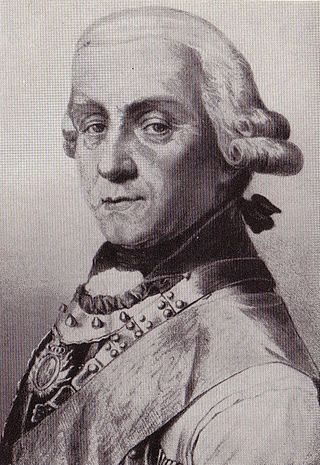
Friedrich Wilhelm Freiherr von Seydlitz was a Prussian officer, lieutenant general, and among the greatest of the Prussian cavalry generals. He commanded one of the first Hussar squadrons of Frederick the Great's army and is credited with the development of the Prussian cavalry to its efficient level of performance in the Seven Years' War. His cavalryman father retired and then died while Seydlitz was still young. Subsequently, he was mentored by Margrave Frederick William of Brandenburg-Schwedt. Seydlitz's superb horsemanship and his recklessness combined to make him a stand-out subaltern, and he emerged as a redoubtable Rittmeister in the War of Austrian Succession (1740–1748) during the First and Second Silesian Wars.

Hans Joachim von Zieten, sometimes spelled Johann Joachim von Ziethen,, also known as Zieten aus dem Busch, was a cavalry general in the Prussian Army. He served in four wars and was instrumental in several victories during the reign of Frederick the Great, most particularly at Hohenfriedberg and Torgau. He is also well known for a raid into the Habsburg territories during the Second Silesian War, known as Zieten's Ride. After engaging in a reputed 74 duels, and fighting in four wars, he died in his bed at the age of 86.

Jakob Ritter von Danner was a Bavarian general in the Imperial German Army and the Reichswehr. As commandant of the Munich garrison of the Reichswehr, he was a central figure in putting down the attempted Beer Hall Putsch by Adolf Hitler and the Nazis in 1923.

Anton Wilhelm von L'Estocq was a Prussian cavalry general best known for his command of the Prussian troops at the Battle of Eylau.

The Zieten Hussars,, last designation: "Hussars Regiment 'von Zieten' (Brandenburg) No. 3", was a hussar regiment of the Prussian Army and later the Imperial German Army, founded in 1730 and named after its first Colonel, Hans Joachim von Zieten.

Karl Ernst Manfred Freiherr von Richthofen was a German General der Kavallerie during World War I and recipient of the order Pour le Mérite, known informally as the Blue Max. Richthofen was a great uncle of his more famous namesake Manfred von Richthofen, known as the Red Baron, who was his godson and named after him.

Karl Ludwig d'Elsa was a Royal Saxon army officer who was a Generaloberst in the First World War and awarded the Pour le Mérite.

Adolf Wilhelm Bernhard von Brauchitsch was a German army officer with the rank of major general. A very experienced officer, he worked with the Army High Command under Hans von Seeckt and in the Ministry of the Reichswehr, before retiring in 1929 due to failing health.

The 10th (Magdeburg) Hussars Regiment (German: Magdeburgisches Husaren-Regiment Nr. 10) were a Prussian Light cavalry regiment of the IV Corps that was formed in late 1813 during the War of the Sixth Coalition against Napoleon after the Battle of Leipzig. The Hussars were a distinctively dressed light cavalry of East European origin. The 10th Hussars were stationed from 1814 to 1884 in Aschersleben and after 1884 in Stendal. They fought in 1866 at the Battle of Königgrätz and later in World War I.
Friedrich Wilhelm Konrad von Brodowski, known as Fritz, was a German army general of the Second World War, successively Commander in Kiev, Ukraine, Commander in Lille, and commanding officer at Clermont-Ferrand.
Karl Weber, from 1917 Ritter von Weber was a German officer, Major General and Commander of the 17th Panzer-Division of the German Army in World War II.

Theodor Wilhelm Gustav Erich Gündell, from 1901 named von Gündell, was a Prussian officer, most noted as a general of infantry in World War I.
Karl Georg Heinrich Bernhard von Poten, known as Bernhard von Poten, was a royal Prussian colonel best known for his military writing.

The 2nd Guards Uhlan Regiment was a cavalry regiment of the Prussian Army formed in 1819 in Potsdam, Prussia, and served as a Guards regiment garrisoned in Berlin.

Joachim Bernhardt von Prittwitz and Gaffron (1726–1793) was a Prussian officer credited with saving the life of Frederick the Great at the Battle of Kunersdorf. At the time, he was a cavalry captain in Hans Joachim von Zieten's Hussar regiment. He became the head of gendarmes regiment, and inspector general of the cavalry of Brandenburg March and Magdeburg in 1775. He was promoted to lieutenant general in 1785 and general of cavalry in 1788. Frederick awarded him the Order Pour le Mérite and the Order of the Black Eagle. In 1851, Prittwitz was included on the panels of the Equestrian statue of Frederick the Great as one of the key figures in the establishment of the Prussia state.
Erich Paul Weber was a German army officer, who served in both the German Imperial Army and the Ottoman Army during World War I, and ultimately attained the rank of General of Infantry.

Hermann Friedrich Staabs, von Staabs was a German infantry general in World War I and commanding general of the XXXIX. Reserve Corps.

Johannes von Busse was a German lieutenant general who was most notable for his service in the Romanian Campaign of World War I.

Georg Karl Kuno Alfred von Larisch (1856-1952) was a German General of the Infantry during World War I. He commanded the 10th Division, the 81st Reserve Division, the Guard Ersatz Division, and the Generalkommando z.b.V. 54 on the Western and Eastern fronts.

Max Heinrich Ludwig was a German General of the Artillery and from 1926 to 1929 chief of the Waffenamt.
















